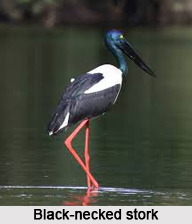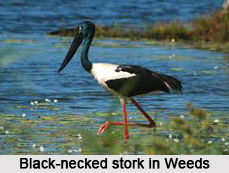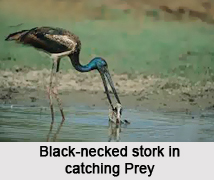 Black-Necked Stork with a scientific name "Ephippiorhynchus asiaticus" is a tall long-necked wading bird in the stork family.
Black-Necked Stork with a scientific name "Ephippiorhynchus asiaticus" is a tall long-necked wading bird in the stork family.
Concentration of Black-Necked Stork
Black-necked stork is a resident species across South and Southeast Asia with a disjunctive population in Australia. It lives in wetland habitats where it forages for a wide range of animal prey.
Sexes of Black-Necked Stork
Adult birds of both sexes have a heavy bill and are patterned in white and glossy blacks, but the sexes differ in the colour of the iris. In Australia, it is sometimes called a jabiru although that name refers to a stork species found in the Americas. It is one of the few storks that are strongly territorial when feeding.
Structure of Black-Necked Stork
Black-Necked Stork is a large bird, 129-150 cm tall having a 230-cm wingspan. The average weight is around 4,100 grams. The plumage patterns are conspicuous with younger birds differing from adults. Adults have a glossy bluish-black iridescent head, neck, secondary flight feathers and tail; a coppery-brown crown; a bright white back belly; bill black with a slightly concave upper edge; and bright red legs. The sexes are identical but the adult female has a yellow iris while the adult male has it brown. Juveniles younger than six months have a brownish iris; a distinctly smaller and straighter beak; a fluffy appearance; brown head, neck, upper back, wings and tail; a white belly; and dark legs. Juveniles older than six months have a mottled appearance especially on the head and neck where the iridescence is partly developed; dark-brown outer primaries; white inner primaries that forms a shoulder patch when the wings are closed; a heavy beak identical in size to adults but still straighter; and dark to pale-pink legs. Like most storks, the black-necked stork flies with the neck outstretched, not retracted like a heron. In flight it appears spindly and a black bar running through the white wings with black neck and tail making it distinctive.
Species of Black-Necked Stork
The two subspecies are recognized E. A. Asiaticus of the Oriental region and E. A. Australis of south New Guinea and Australia. Charles Lucien Bonaparte erected the genus Xenorhynchus in 1855 and placed two species in it, X. indica and X. australis. This treatment was carried on into later works. James Lee Peters in his 1931 work treated them as subspecies. In 1989, Mc.Allan and Bruce again suggested the elevation of the two subspecies into two species: E. asiaticus or the green-necked stork of the Oriental region, and E. australis or the black-necked stork of the Australian and New Guinean region. This recommendation was based on the disjunct distributions and differences in the iridescent colouration of the neck which the authors suggested might reflect different behavioural displays. This recommendation has not been followed and a subsequent study did not find consistent differences in the colours.
Residence of Black-Necked Stork
Black-necked stork is widespread in the west, central highlands, and northern Gangetic plains into the Assam valley, but somewhat rare in peninsular India and Sri Lanka. This distinctive stork is an occasional straggler in southern and eastern Pakistan. It extends into Southeast Asia, through New Guinea and into the northern half of Australia. Compared to other large water birds like cranes, spoonbills and other species of storks, black-necked storks are least abundant in locations with a high diversity of water bird species.
Population of Black-necked stork
The largest population of Black-necked stork occurs in Australia, where it is found from the Ashburton River, near Onslow, Western Australia, across northern Australia to north-east New South Wales. It extends inland in the Kimberley area to south of Halls Creek; in the Northern Territory to Hooker Creek and Daly Waters; and in Queensland inland to the Boulia area and the New South Wales border, with some records as far south as the north-west plains of New South Wales, along the coast of Sydney and formerly bred near the Shoalhaven River.
Population of Black-Necked Stork in India
 The breeding population occurs in the largely cultivated landscape of south-western Uttar Pradesh in India. The population densities of about 0.099 birds per square kilometre have been estimated in this region made up of a mosaic of cultivated fields and wetlands. About six pairs were found to use the 29 square kilometres of the Keoladeo Ghana National Park, Rajasthan. In Sri Lanka, the species is a rare breeding resident, with 4-8 breeding pairs in Ruhuna National Park. It is exceedingly rare, and possibly extinct as a breeding bird, in Bangladesh and Thailand.
The breeding population occurs in the largely cultivated landscape of south-western Uttar Pradesh in India. The population densities of about 0.099 birds per square kilometre have been estimated in this region made up of a mosaic of cultivated fields and wetlands. About six pairs were found to use the 29 square kilometres of the Keoladeo Ghana National Park, Rajasthan. In Sri Lanka, the species is a rare breeding resident, with 4-8 breeding pairs in Ruhuna National Park. It is exceedingly rare, and possibly extinct as a breeding bird, in Bangladesh and Thailand.
Habitats in Black-Necked Stork
Black-Necked Storks forage in a variety of natural and artificial wetland habitats. They frequently use freshwater, natural wetland habitats such as lakes, ponds, marshes, flooded grasslands, oxbow lakes, swamps, rivers and water meadows. Freshwater, artificial wetland habitats used by these storks include flooded fallow and paddy fields, wet wheat fields, irrigation storage ponds and canals, sewage ponds, and dry floodplains. In cultivated areas, they prefer natural wetlands to forage in, though flooded rice paddies are preferentially used during the monsoon, likely due to excessive flooding of lakes and ponds.



















